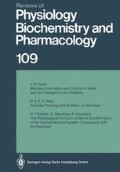Abstract
In this paper we discuss the strong coupling limit of chiral N=1 supersymmetric gauge theory via their embedding into M-theory. In particular we focus on N=1 brane box models and show that after a T-duality transformation their M-theory embedding is described by supersymmetric 3-cycles. Brane box models with uniform bending lead to 3-cycles which consist out of intersecting Seiberg-Witten curves. We discuss a few aspects of the intersection pattern in case of two intersecting tori which corresponds to N=1 SUSY QCD with N c =N f =4.
Preview
Unable to display preview. Download preview PDF.
References
N. Seiberg and E. Witten, “Electric-magnetic duality, monopole condensation, and confinement in N=2 supersymmetric Yang-Mills theory,” Nucl. Phys. B426 (1994) 19–52.
A. Karch, D. Lüst, and D. Smith, “Equivalence of geometric engineering and Hanany-Witten via fractional branes,” Nucl. Phys. B533 (1998) 348.
A. Klemm, W. Lerche, P. Mayr, C. Vafa and N. Warner, “Selfdual strings and N=2 supersymmetric field theory,” Nucl. Phys. B477 (1996) 746.
A. Hanany and E. Witten, “Type IIB superstrings, BPS monopoles, and three-dimensional gauge dynamics,” Nucl. Phys. B492 (1997) 152–190.
E. Witten, “Solutions of four-dimensional field theories via M theory,” Nucl. Phys. B500 (1997) 3.
K. Hori, H. Ooguri, and Y. Oz, “Strong coupling dynamics of four-dimensional N=1 gauge theories from M theory five-brane,” Adv. Theor. Math. Phys. 1 (1998) 1–52
E. Witten, “Branes and the dynamics of QCD,” Nucl. Phys. B507 (1997) 658
A. Brandhuber, N. Itzhaki, V. Kaplunovsky, J. Sonnenschein and S. Yankielowicz, “Comments on the M theory approach to N=1 SQCD and brane dynamics,” Phys. Lett. B415 (1997) 127.
A. Hanany and A. Zaffaroni, “On the realization of chiral four-dimensional gauge theories using branes,” hep-th/9801134.
K. Landsteiner, E. Lopez and D. A. Lowe, “Duality of chiral N=1 supersymmetric gauge theories via branes,” hep-th/9801002
I. Brunner, A. Hanany, A. Karch, and D. Lüst, “Brane dynamics and chiral nonchiral transitions,” Nucl. Phys. D528 (1998) 197.
A. Karch, D. Lüst, A. Miemiec, “N=1 Supersymmetric Gauge Theories and Supersymmetric 3-cycles,” hep-th/9810254.
M. Aganagic, A. Karch, D. Lüst and A. Miemiec, paper in preparation.
G. W. Gibbons and G. Papadopoulos, “Calibrations and intersecting branes,” hep-th/9803163; J. P. Gauntlett, N. D. Lambert and P. C. West, “Branes and calibrated geometries,” hep-th/9803216.
M. Douglas and G. Moore, “D-branes, Quivers and ALE instantons,” hep-th/9603167.
I. R. Klebanov, E. Witten, “Superconformal Field Theory on Threebranes at a Calabi-Yau Singularity,” Nucl.Phys. B536 (1998) 199–218.
A. Hanany, A. M. Uranga, “Brane Boxes and Branes on Singularities,” J. High Energy Phys. 9805 (1998) 013; A. M. Uranga, “Brane Configurations for Branes at Conifolds,” hep-th/9811004.
A. Klemm, W. Lerche, S. Yankielowicz and S. Theisen, “Simple singularities and N=2 supersymmetric Yang-Mills theory,” Phys. Lett B344 (1995) 169
P.C. Argyres and A.E. Faraggi, “The vaccum structure and spectrum of N=2 supersymmetruc SU(n) gauge theory,” Phys. Rev. Lett. 74 (1995) 3931.
R. G. Leigh and M. J. Strassler, “Exactly marginal operators and duality in four-dimensional N=1 supersymmetric gauge theory,” Nucl. Phys. B447 (1995) 95–136.
A. Hanany, M. J. Strassler, and A. M. Uranga, “Finite theories and marginal operators on the brane,” hep-th/9803086.
E. G. Gimon and M. Gremm, “A note on brane boxes at finite string coupling,” hep-th/9803033.
A. Hanany and A. M. Uranga, “Brane boxes and branes on singularities,” hep-th/9805139.
K. Becker, M. Becker and A. Strominger, “Five-branes, membranes and nonperturbative string theory,” hep-th/9507158.
R. Harvey and H. B. Lawson “Calibrated geometries,” Acta Mathematica 148.
J. M. Souriau “Construction explicite de l’indice de Maslov”
Author information
Authors and Affiliations
Editor information
Rights and permissions
Copyright information
© 1999 Springer-Verlag
About this paper
Cite this paper
Karch, A., Lüst, D., Miemiec, A. (1999). Supersymmetric 3-cycles for N=1 brane box models. In: Ceresole, A., Kounnas, C., Lüst, D., Theisen, S. (eds) Quantum Aspects of Gauge Theories, Supersymmetry and Unification. Lecture Notes in Physics, vol 525. Springer, Berlin, Heidelberg. https://doi.org/10.1007/BFb0104264
Download citation
DOI: https://doi.org/10.1007/BFb0104264
Published:
Publisher Name: Springer, Berlin, Heidelberg
Print ISBN: 978-3-540-66005-7
Online ISBN: 978-3-540-48792-0
eBook Packages: Springer Book Archive

